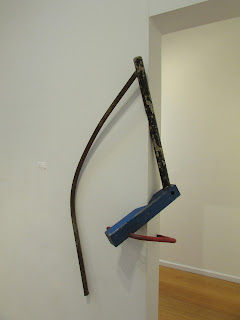Saturday, 27 November 2021
Telfer Stokes - Yonder - Recent Work
Saturday, 20 November 2021
The Making of Rodin
So, having been to see the Houseago/Rodin show at Gagosian (here), it was to Tate Modern to see a retrospective devoted solely to the sculpture of Rodin. This exhibition was all the better for being undisturbed by the need for 'dialogues' with any other artists. With the exception of three works, one in bronze and the others in marble, all of the exhibited works are plaster, on loan from the Rodin museum in Paris. With most of the exhibits being white plaster there is a stark, ethereal, feel to this exhibition. I think this was a good ploy by the curators as the sculptures all appear to be works in progress so your imagination provides you with a sense of perhaps being in the studio with Rodin. I found myself trying to visually process his thoughts and working methods. It was a surprise to learn that Rodin himself rarely, if ever, carved his sculptures with a hammer and chisel in the long tradition of Michelangelo and other sculptors. Rodin instead farmed this aspect of his working process out, commissioning assistants who worked from his clay or plaster models to carve them in marble, or specialist founders to cast them in bronze in a wide variety of sizes. Visitors to the exhibition are greeted at the entrance by the familiar huge marble The Kiss, with its pair of lovers (inspired by sinners from Dante's Inferno) locked in an amorous embrace, oblivious to all, completely rapt in their act of intimacy. The figures were derived from designs and maquettes for a large work The Gates of Hell, (as was the iconic figure of The Thinker), which wasn't completed in his lifetime. The exhibition proper opens with the incredibly naturalistic nude of a youth - The Age of Bronze, which caused such a stir on its unveiling that Rodin was accused of casting it directly from the model rather than using his own hands and artistic talent. These accusations saw Rodin change tack and focus on capturing movement in his work. As a result much of his oeuvre henceforth contained a dynamism and lyricism, as if the subjects are captured for a fleeting second in activity. The Age of Bronze sculpture looks all the more stunning for being well lit and given its own room here where it solely commands the space. Rodin is a master of depicting emotion in his sculptures through both gesture and facial expression. This skill works well to emphasise the sense of tension and pathos in the backstory of works such as The Burghers of Calais who are captured by Rodin as bedraggled and in a state of surrender, ready to face the gallows before making the ultimate sacrifice. This expressive quality is also captured in Rodin's powerful yet graceful depictions of hands. It was a real pleasure to see what Rodin termed his abattis, which translates as 'giblets' - a series of tiny modelled, heads, arms and hands in a vitrine. I was minded to recall last years exhibition of hand prints by Georg Baselitz (here). Another pleasing sight having missed the 2019 exhibition at the British Museum, were Rodin's playfully odd interventions with the ceramics of ancient civilisations. These interventions in which Rodin added his little plaster figures to pottery bowls were described perfectly by poet Rainer Maria Rilke as being 'floral souls'. By adding his own miniature figures to these objects Rodin was unwittingly predating Duchamps readymades, and at the same time ruining both the object and value of these ancient artefacts. My mind made several leaps to the works of other artists with certain of Rodin's sculptures - Michelangelo as mentioned previously, and Goya's macabre Caprichos series of etchings on seeing a piece featuring a collection of dismembered Rodin hands and heads presided over by a sinister winged figure, and then Degas' clay and bronze dancers in Rodin's own plaster dancers going through their paces supported by a metal armature. It was really heartening to see many other visitors being actively inspired, sketching from Rodin's powerful casts, and to see some of the sketches by the artist himself, a couple of which rivalled the eroticism of the sketches of Gustav Klimt and Egon Schiele. This was yet another enlightening exhibition by the Tate, which served to highlight Rodin's genius perfectly.
















































































